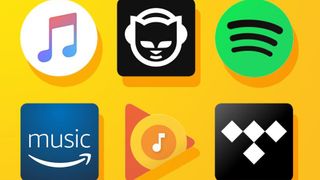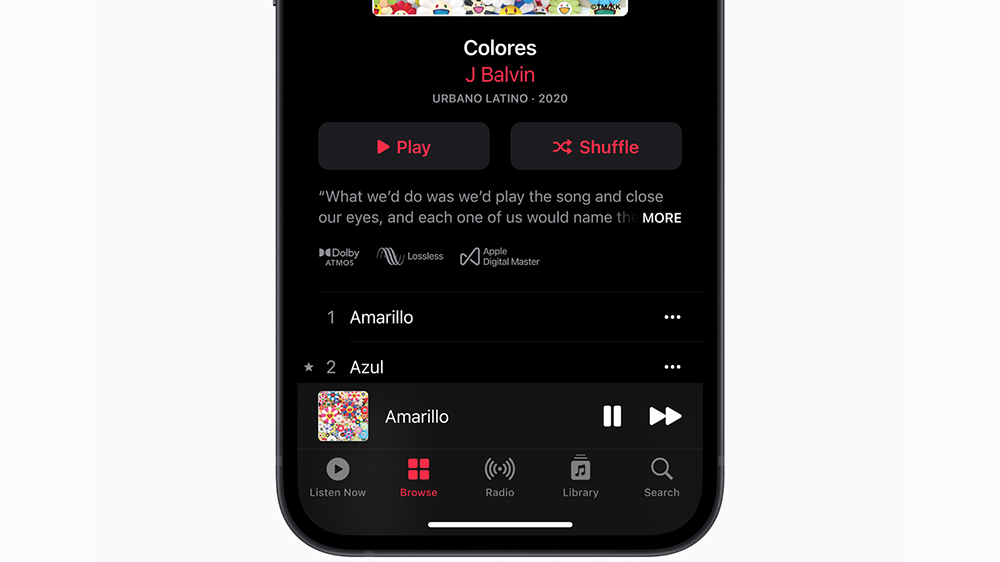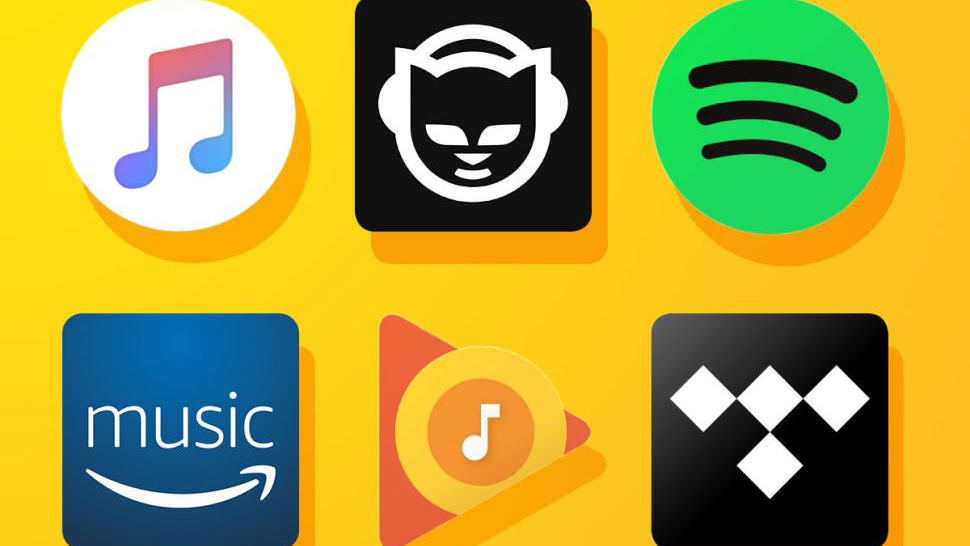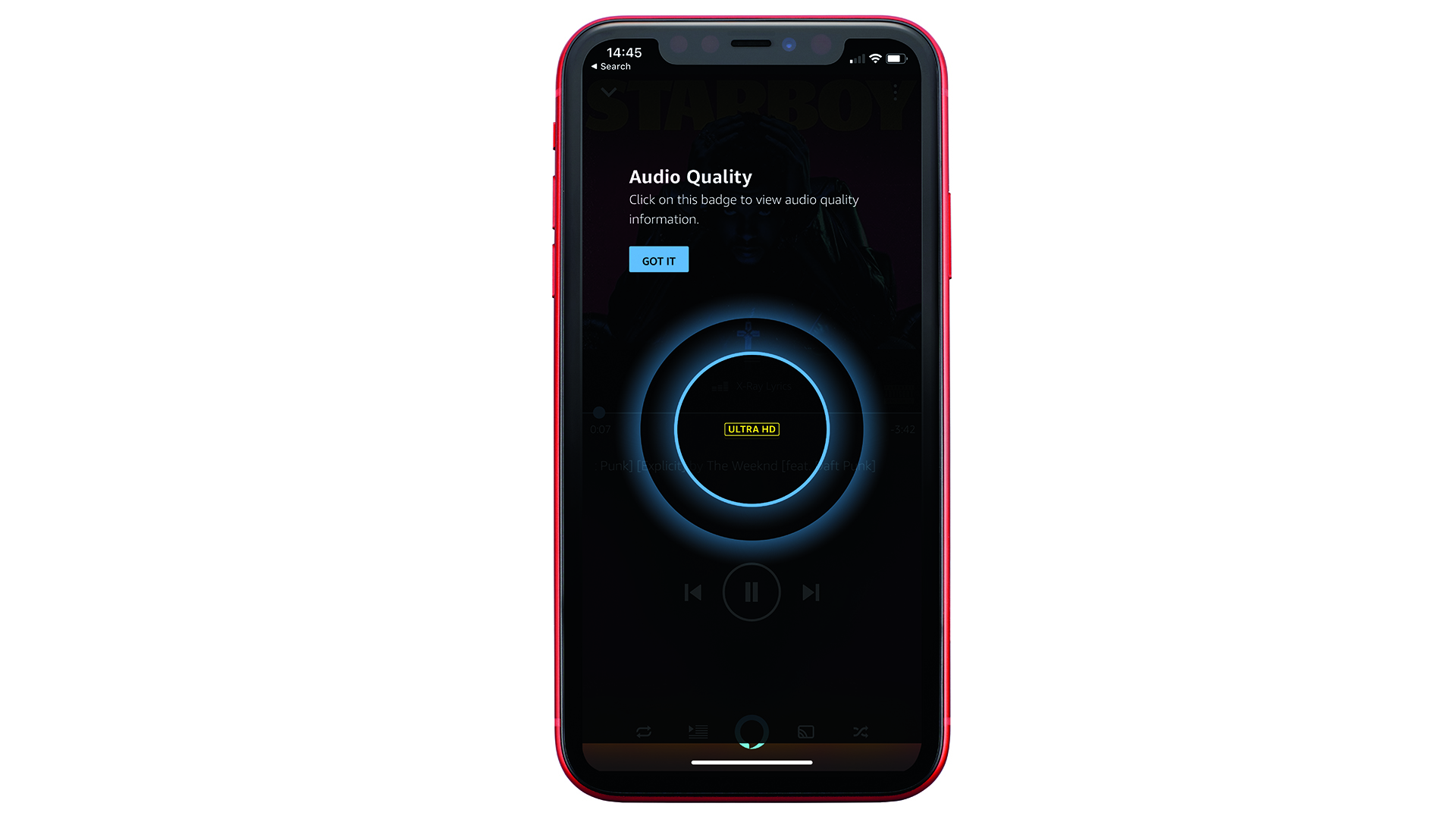Which Audio Streaming Service Has The Best Lossless Audio?
Hi-res music streaming services compared: which should yous sign upwardly for?

The boxing to become the best music streaming service offer hi-res streams is well and truly underway. Gone are the days when all a streaming platform had to practice was offer up low-quality OGG VORBIS or MP3 streams and make you endure a few ads for the privilege. In 2022, the key to victory is ad-free, unlimited streaming in high-resolution quality – and, crucially, for the best cost.
Tidal is perhaps the most established in this realm. It is our favourite service, too, and holder of a 2021 What Hi-Fi? Award in the music streaming service category. Since January 2017, its £20 ($20, AU$24) per month tier has granted access to hi-res (typically 24-flake/96kHz) Tidal Main streams, encoded using MQA (Master Quality Authenticated) technology. More recently, Tidal actually divide its membership options into HiFi (with a resolution cap of 1411kbps, aka CD-quality streams) and HiFi Plus, offering upwards to 9216kbps along with Dolby Atmos and Sony 360 Reality support, for the top-tier £20 fee. So, is Tidal HiFi Plus the respond? It's certainly 1 respond, but there are other options...
Qobuz, which was really first to the hi-res streaming game (except in Australia, where it but launched in 2021) is still kicking almost with a £xv ($xv and now, AU$25) per month hi-res service. Information technology also has a £250 ($250, AU$300) annual subscription called Studio Sublime that combines hi-res streaming with discounts on 24-bit download purchases.
There'southward also Amazon, which announced in May 2021 that its howdy-res-inclusive Music Hard disk tier (which we chosen "up in that location with the all-time") was at present free for all Amazon Music Unlimited subscribers. This ways hi-res streaming for £8 ($eight, AU$7) per month for Prime members, or £ten ($x, AU$12) per month if you lot don't accept Prime.
And then in that location's Apple Music, which casually upgraded its offering to lossless sound (and Spatial Audio, with or without hardware-dependent caput-tracking) at no extra charge to its subscribers final year (£10, $10, AU$12), thus leaving Spotify'due south yet yet-to-launch Spotify HiFi looking similar it will have to come as a gratis upgrade just to stay competitive...
So where does the arrival of these newer, competitively priced hello-res services leave Tidal and Qobuz, and even services not in the hi-res game (Deezer, for example, 'only' offers CD quality)? How will they convince customers to stick around for howdy-res audio at comparatively hiked prices side by side to the likes of Apple tree and Amazon?
And most importantly, which service best deserves your monthly subscription?
Below, nosotros try to help you make up one's mind simply that, starting with the differences between lossless and howdy-res music, and offering a breakdown of the services and their USPs. Get ready: your music is about to sound a lot meliorate.
Streaming services compared – at a glance
| Service | Free tier | Monthly hi-res price | Supported formats | Max streaming quality |
| Spotify | Yeah, ad-supported, 128kbp | - | OGG | 320kbps (for now) |
| Apple Music | No | £x ($10, AU$12) | AAC, ALAC | 24-scrap/192kHz |
| Tidal | Yeah, (US only) | £20 ($xx, AU$24) | MQA, AAC, ALAC, FLAC | 24-bit/192kHz |
| Deezer | Yes, ad-supported, 128kbps | - | FLAC | 16-flake/44.1kHz |
| Amazon Music HD | No | £10 ($10, AU$12), or £8 ($8, AU$7) for Prime Members | FLAC | 24-flake/192kHz |
| Qobuz | No | £15 ($xv, AU$25) | AIFF, ALAC, FLAC, WAV, WMA Lossless | 24-bit/192kHz |
| YouTube Music | Yes, advertisement-supported, 126kbps | - | AAC | 256kbps |
What is hi-res streaming and why should you want it?

Offset things beginning, should yous care about hi-res streaming? High-resolution (oftentimes shortened to 'hi-res') audio is a term used to describe music files that take a higher sampling frequency and/or fleck depth than that of CD-quality, which is specified at xvi-bit/44.1kHz. So a hi-res file can exist 24-bit/44.1kHz, where bit-depth is higher than CD quality but sampling rate is the same, and vice versa.
So what do the numbers hateful? It might help to think of an audio signal as a sound wave being plotted on a graph. Sampling charge per unit – the second number – refers to the number of times per 2d that the wave is measured during the analogue-to-digital conversion process. The higher the sampling charge per unit, the more times the audio point has been sampled, and thus the more than detail resolution y'all get.
The first number is bit-depth, which indicates the number of 'bits' of data present in each sample of the signal. Going from sixteen bits to 24 $.25 results in a massive increase of dynamic range, which is the gap between the quietest and loudest sounds that can exist captured. In numbers, it's a bound from 96dB to 144dB, which is huge.
Streams from Spotify and Apple tree Music use compressed file formats with relatively low bitrates, such as 320kbps Ogg Vorbis streams on Spotify Premium (if you're a Spotify Free user, your file quality volition actually max out at 160kbps) and 256kbps AAC files on Apple Music.
This 'lossy' compression means that certain data is scrapped in the encoding process for the sake of convenience and smaller file sizes. Obviously, this affects the audio quality.
To illustrate why hello-res should sound amend than, say, an MP3, we demand simply to compare the relative bitrates (the amount of information being transferred measured in kilobits per second). The highest quality MP3 has a bitrate of 320kbps. A 24-flake/192kHz file takes that to 9216kbps. Music CDs are 1411kbps – remember, they're your starting mark for hi-res.
The how-do-you-do-res 24-bit/96kHz or 24-bit/192kHz files should, therefore, more than closely replicate the sound quality the musicians and engineers were working with in the studio. Provided your system is transparent enough, playing hullo-res music can bring y'all more than item and texture, thus bringing you closer to what the artist wanted to say when they recorded their work. And isn't that what we want?
Although hi-res sound songs and albums have been bachelor to download for several years now, streaming hi-res sound is relatively new beyond pop music subscription platforms – and some nevertheless don't offer it.
- Loftier-resolution sound: everything yous need to know
Hi-res vs lossless: what's the difference?

While the terms 'lossless' and 'hi-res' may exist used in shut connection – Apple tree Music has launched Lossless and Hullo-Res Lossless labels and, to complicate matters further, Amazon Music prefers the terms Hard disk drive and UHD when referring to its more premium audio offerings – music that is 'lossless' is not ever hi-res.
Here's the matter: where hi-res sound is defined equally music that has a resolution college than CD quality, lossless sound has no set specification in terms of bitrate. The term covers only how much data has been thrown out during the encoding process and, as a issue, how much quality or "loss" you lot volition feel when you play it.
If no pinch algorithm (or codec) has been used to compress the sound within your particular file, two things happen: lossless (though non necessarily hi-res) sound quality, and pretty soon a storage warning on your device.
WAV and AIFF are the most prominent uncompressed audio file formats, both based on PCM (Pulse Code Modulation), which is the most common digital encoding method employed. They can both shop CD-quality or high-resolution audio files. The drawback? These audio files are large. A CD-quality (16-bit/44.1kHz) lossless file will have around 10MB of your hard drive per minute in length.
Now, permit's introduce FLAC. As its name (Free Lossless Audio Codec) suggests, it's a lossless file, just information technology has been cleverly packaged to almost half the size of an uncompressed WAV or AIFF of equivalent sample rate. Other lossless simply compressed audio file formats include ALAC (Apple Lossless) and WMA Lossless (Windows Media Audio).
Then far, we've talked about uncompressed lossless files and compressed lossless files. Now, we'll talk compressed lossy files. This is where our old friend the MP3 comes in – a file format that compresses a file and reduces its size by discarding data that cannot be retrieved again. Other examples of lossy compressed files are OGG (of Ogg Vorbis fame) and Apple tree's AAC.
- MP3, AAC, WAV, FLAC: all the audio file formats explained
Which streaming services offering hello-res music?

Brusk answer: Tidal, Amazon Music HD, Qobuz and Apple Music.
Here'southward an explainer on each service, the tech they apply to deliver hi-res, what yous'll need to play it, and, crucially, for whom each service volition probable suit best.
Tidal – for MQA-enabled kit

Tidal has been riding the hi-res wave since 2017 when it began offer how-do-you-do-res audio streaming thanks to the adoption of MQA applied science. These hullo-res (typically 24-bit/96kHz) 'Tidal Masters' tracks now have a significant presence in the catalogue alongside CD-quality streams – all available to subscribers of its £twenty ($twenty, AU$24) per month HiFi Plus packet.
Tidal's availability is on the rise, too: there's desktop and mobile apps, web role player, Google Chromecast, Apple CarPlay, Apple Watch support, and integration into several networked hi-fi products' offerings, from Sonos, Bluesound and DTS Play-Fi platforms to Linn, McIntosh, Naim and Cyrus streaming products. But not all of these support hi-res playback of Tidal'south Masters.
Masters are now available via both Android, iOS and desktop apps, and hi-fi components and platforms that support MQA. Tidal Connect – a similar concept to Spotify Connect – also allows for easy streaming to compatible products from within the native Tidal app, and it's able to bandage Tidal Masters too.
At present for the howdy-res pocket-sized print: playing Tidal Masters through the Tidal desktop app on a figurer, via its iii.5mm headphone output or a continued (non-MQA-enabled) DAC gives the Tidal desktop app the reins over MQA's core decoding, which has a limited output of 24-bit/96kHz. In other words, fifty-fifty if you're streaming a 192kHz file, information technology will only be unpackaged to 96kHz.
Similarly, the iOS and Android apps can complete simply the get-go 'unfold' of MQA file decoding, outputting streams at a maximum of 24-bit/96kHz. The only style to entirely unpackage an MQA file for playback (and therefore give you the all-time representation of the file data) is by pairing your computer or Apple or Android device with an MQA-uniform DAC, taking the decoding procedure abroad from the software (Tidal app).
The benefit of owning kit with built-in MQA decoders – such as the Audirvana Plus three estimator software, the NAD C 658 music streamer, the Cambridge Audio DacMagic 200M and AudioQuest DragonFly Cobalt DAC – is that all decoding is done by the hardware, which tin can unpackage the unabridged MQA file for playback in its original resolution.
Tidal also offers a growing catalogue of immersive sound tracks via its support of Dolby Atmos Music and Sony 360 Reality Audio. The sometime ways you can play Atmos tracks through Atmos-compatible kit, from soundbars and TVs to AVRs and smart speakers. Tidal HiFi subscribers demand to connect their Atmos-enabled device to a uniform streamer running the most recently updated Tidal app. Supported streaming devices include the Apple Idiot box 4K, Amazon Fire TV Stick 4K, Fire TV Cube, Burn down TV Stick (2d gen), Fire Telly (3rd gen), Nvidia Shield TV and Nvidia Shield Television set Pro (2019 or newer).
- Tidal tips, tricks and features
Amazon Music Hard disk – hi-res on a budget (especially for Prime members)

Whichever way you arroyo it, Amazon has gone super aggressive on pricing. In response to Apple Music'southward howdy-res streaming announcement in 2021, Amazon made its Music Hard disk drive tier complimentary for Amazon Music Unlimited subscribers. The Individual Plan nevertheless costs £viii ($8, AU$7) per calendar month for Prime members and £10 ($ten, AU$12) per month for Amazon customers – but now, your subscription fee includes Amazon's highest-quality audio at no extra charge. The Amazon Music Hd tier was previously an additional £5 ($5) per month – and the company simply launched its HD tier in Australia in 2021.
You tin access Amazon Music Hard disk drive through 3 dissimilar avenues: a web browser, the desktop app, or through the Android and iOS mobile apps. However, it's worth noting that you can't really stream CD-quality music or hi-res tracks through your browser, merely the apps.
Nosotros demand some other hi-res terminology give-and-take, though. Confusingly, Amazon Music Hard disk doesn't employ the term 'Hard disk drive' when information technology's discussing high-resolution audio. Where y'all see tracks labelled 'HD', this actually means that they're CD-quality. Amazon has decided to refer to and label hi-res music as 'Ultra Hard disk drive'. Why? Presumably information technology feels that this labelling will bear witness clearer for a mass audience. And mayhap information technology's correct. Anyhow, the files you'll become are really FLACs.
Amazon refers to HD tracks as having a "bit depth of xvi-bits, a minimum sample rate of 44.1 kHz (also referred to every bit CD-quality), and an average bitrate of 850 kbps". UHD tracks, on the other hand, "have a flake depth of 24-$.25, sample rates ranging from 44.1 kHz up to 192 kHz, and an average bitrate of 3730 kbps."
To Amazon's credit, it pushes Ultra HD content extremely hard on the service with dedicated playlists and clear labelling, e.g Best of Ultra HD, Ultra HD: New Arrivals, Ultra HD Hip-Hop and Ultra HD Jazz. Information technology doesn't have long to observe a steady stream of UHD music to listen to.
Should you lot ain an Amazon Echo Studio speaker, you'll also exist able to access Amazon'due south catalogue of 3D audio tracks, of which Amazon claims there are well over 750 encoded in either Dolby Atmos or Sony 360 Reality Audio.
Qobuz – for Sonos users and/or avid downloaders

Qobuz is the showtime streaming giant to have dropped MP3 streaming entirely, going all-in on CD-quality and hi-res streaming. In truth, taking a stand is nothing new to Qobuz, a visitor that tends to do things differently from most of its rivals in the music streaming world.
The French service has been effectually since 2007 (the same amount of time as Spotify) but it left its domicile borders only in 2013, when it became the first CD-quality streaming service to hit the UK. Tidal joined the ranks a couple of years later. Information technology was likewise the get-go to offering hi-res streams.
There are two packages from which users can choose: the Studio Premier plan (£fifteen/$xv/AU$25 per month or £150/$150/AU$230 per year) for streaming of Qobuz'due south 50 meg-runway library; and Studio Sublime, which too throws in discounted purchases of 24-scrap downloads, priced £250/$250/AU$300 for the year (downwardly from £350/$350 last year; then unavailable in Australia).
The principal sticking betoken for us at the beginning, despite information technology besides sounding a little less sugariness than its Tidal equivalent, was the service'southward high price. Only Qobuz's most recent discount – not to mention its coin-saving Family deals – has seen it ascent quite significantly in value.
Qobuz is now available on lots of devices. There's a web thespian every bit well as desktop (Mac and PC) and mobile (iOS and Android) apps, plus integration into a wide range of hi-fi products. Google Chromecast is a large bargain hither, as it means adding Qobuz to an existing 'dumb' howdy-fi is as unproblematic and affordable as calculation a Chromecast dongle, and many hello-fi companies are now adding Chromecast support into their streaming components, thereby increasing Qobuz'southward availability.
Broadly speaking, well-nigh devices that back up Tidal too support Qobuz and vice versa, and both services are bachelor only in CD-quality via some streamers.
A major feather in Qobuz'due south cap, notwithstanding, is that information technology is the showtime service to make 24-fleck how-do-you-do-res streaming available on Sonos products. Given how long we've waited for our favourite multi-room family unit to adopt howdy-res, it'south quite a big deal.
Qobuz's (comparatively) high price has always been partly justified by its exhaustive library of hi-res music. Recent figures land Qobuz at present has over 424,000 hullo-res quality albums, while Tidal claims 'but' more than than 1m tracks. Numbers rarely tell the whole story, only nosotros regularly discover hullo-res albums on Qobuz that are available in simply CD-quality on Tidal. On the flip side, however, we often find albums on Tidal, Spotify, Apple Music and Deezer that aren't available on Qobuz at all – which nosotros would argue is a far bigger issue...
With Qobuz, bitrate and frequency are displayed in the playback bar, and hi-res albums are conspicuously flagged with the familiar 'Hi-Res Audio' logo, both in the library interface and playback bar – picayune things that we wholeheartedly wish other streaming services would include.
Apple Music – for Apple device owners

Apple offers CD-quality (16-bit/44.1kHz), Apple Music Lossless (24-bit/48kHz) and Hi-Res Lossless (upward to 24-chip/192kHz) streams via its ALAC (Apple tree Lossless Sound Codec) codec. And the best bit? If you subscribe to Apple tree Music at £10 ($10, AU$12) per month, there's no extra accuse for these higher-quality streams. That puts information technology on a par with Amazon, and much cheaper than Tidal and Qobuz.
All of Apple Music'southward 90-million-strong music catalogue is at present available in CD quality or Apple tree Music Lossless. At launch, the visitor claimed that 20 million tracks were accessible in the highest quality Hi-Res Lossless format, with the whole catalogue following by the stop of 2021.
Having heard Apple's Hi-Res Lossless catalogue, we can tell you that there'south plenty to get excited well-nigh – unless you but bought a new pair of AirPods.
Here's the rub: although Apple Music with Dolby Atmos works with all headphones and Apple tree'due south own HomePod and HomePod Mini support Lossless (although merely the original HomePod supports Spatial Sound), Apple'due south own headphones don't support lossless audio. None of them. That means even if you've spent £549 ($549, AU$899) on a pair of AirPods Max, while y'all can get head-tracked spatial audio from an Apple tree device, you can't listen to Apple Music in the highest quality. Peeved? We don't arraign yous.
Apple'south iPhones (since the iPhone 7) natively back up lossless – but only Apple Music Lossless, and non the highest quality Hi-Res Lossless. If you want to mind to Apple tree Music tracks above 24-chip/48kHz on your iPhone, y'all'll need to connect an external DAC and use a wired pair of headphones. Check out our guide for how to listen to hi-res audio on an iPhone.
The same is true of the Apple tree Goggle box and iPad families, which are listed as supporting Apple Lossless, with no mention of Hi-Res Lossless.
Like Amazon and Tidal, Apple Music too now has immersive sound tracks – this time through Apple's proprietary Dolby Atmos-powered Spatial Audio format, designed to provide "multidimensional audio and clarity"; to deliver surround audio and 3D audio via your headphones. These tracks will play automatically on AirPods or Beats headphones with a W1 or H1 chip. The HomePod also supports Spatial Sound, and then you can fill your room with virtual 3D audio from a unmarried device. As do the iPhone 11 onwards and iPad Pro (but not iPad, iPad Mini or iPad Air). Playing from an Apple tree TV 4K into a Dolby Atmos soundbar or arrangement will work as well.
- Apple Music tips, tricks and features
Services that do not support hullo-res... nonetheless

Another short answer: Deezer, Spotify and YouTube Music are yet to offer (or even hope to offering) hello-res sound. We know that Spotify is set to launch its long-awaited and seemingly delayed 'HiFi' tier (which was promised by the end of 2021 but never materialised) at some point, but it remains to be seen whether hi-res will be on the bill of fare at launch or whether it volition stick to CD quality – and if it will try to undercut the competition.
Then will Deezer (which offers CD-quality) or YouTube Music (which maxes out at 256kbps inside its paid-for tier) always become hi-res? Alexander Kingdom of the netherlands, chief content and strategy officeholder at Deezer, offered some choice words on this last year: "Our goal is to brand sure that Deezer brings value to both artists and music fans. We're not fix to announce anything just still but are considering the implications on our users, technology and business organization. It's clear that our manufacture shifted overnight and HiFi is the new de facto standard for audio quality. We would never want to stand up in the way of that. Y'all'll hear more from us soon."
Intriguing.
Verdict: which how-do-you-do-res streaming service is best?
Ultimately, the delicate balance of upkeep and device compatibility within your abode volition determine which service you opt for.
Tidal is our current Honor winner: it sounds that little bit amend than the competition, the user experience is spot on, the catalogue all-encompassing, and the accessibility of hi-res Masters streams on MQA-supporting devices is only growing. That said, it has still to react to the latest price war on hello-res streams, bar setting up a free, ad-supported and lesser-quality tier in the Us. If information technology'southward hello-res yous want, Tidal is at present double the cost of Apple Music and Amazon Music HD.
Qobuz is now a proficient shout for Sonos users looking to bring hello-res sound to their homes and it does take the biggest how-do-you-do-res catalogue. Admirably, it offers users the chance to buy and download music (at a discount for Studio Sublime members), although we'd note the significant holes in its standard CD-quality album offering.
Amazon Music Hd has recently positioned itself as one of the cheapest hi-res options, and could well exist the service of option for non-Apple users who want the best sound for the least pound.
With its high-quality catalogue present and growing, Apple tree Music is a no-brainer for iPhone owners and a prerequisite for owners of the excellent HomePod/HomePod mini. The downside is that even if you're heavily ensconced in Apple's ecosystem, y'all'll yet need to invest in third-party products to enjoy lossless and hello-res at their fullest.
More than:
Got the service? Now read how to choose the right speakers and go the best audio
Still waiting for Spotify HiFi? Sorry, merely Spotify'due south CEO doesn't know when its howdy-res streaming tier will launch
Further reading (and if you're struggling to hear the difference) the trouble with hi-res sound is how you lot might be listening to information technology
Which Audio Streaming Service Has The Best Lossless Audio?,
Source: https://www.whathifi.com/us/advice/hi-res-music-streaming-services-compared
Posted by: elwellsearenes.blogspot.com


0 Response to "Which Audio Streaming Service Has The Best Lossless Audio?"
Post a Comment